How to build your own electromagnet and dc motor
that will really work
Make a simple and efficient DC motor
DC Motor
There are lots of "designs" on the web for "simple dc motors" but most are very inefficient, and will not produce an output that can drive equipment. This design is different because it uses a fixed coil (stator) and magnetised rotor.
You will need very few items.
List of parts
- wooden baseboard. Around 6" * 4" will be fine, around 0.5 inch thick.
- an old wooden cotton reel (or if not a plastic one).
- a length of steel studding (8 0r 10 mm dia) and some nuts and washers to fit.
- 2 "penny" washers or similar
- some copper water pipe (12mm or 18mm) just a few inches. Or a solder-fit copper pipe coupling.
- plastic or rubber pipe to fit inside the above.
- 4 steel angle brackets - 4 to 6 inches long.
- stiff copper wire (to make the brushes) - can be taken from 30A solid core T&E mains cable. About a foot.
- "bell wire" stranded core wire for making connections.
- reel of insulating tape.
- electrical terminal strip connector.
- 250g enamelled copper wire - about 0.2mm dia. (36SWG, 32AWG) (ebay) (coil wire) - you get nearly 1km of wire!
- 2 strong neodymium magnets about 10mm dia * 4mm deep (you can stick them together if they are thin)
Construction:
Your finished motor should look like this..
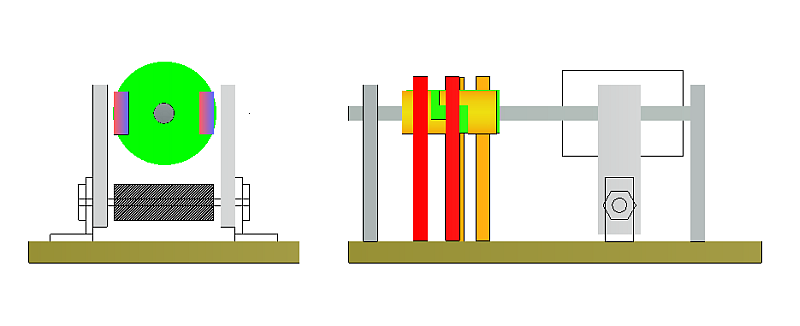
Rotor:
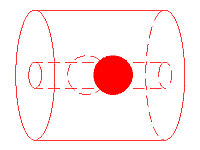 Take the cotton reel and drill out the centre hole (if needed) to fit the studding.
Take the cotton reel and drill out the centre hole (if needed) to fit the studding.
Cut out holes to fit the magnets on opposite sides of the cotton reel, and glue the first in place. Apply the second magnet to the other side so that it is attracted towards the first; then glue in place. You can fill the reel with plaster to add weight.
* If you cant find a suitable reel, you can cast a rotor using a small tin can (eg tomato puree tin) as a mould. Mix plaster of paris or polyfilla, add some PVA glue and mix in some reinforcing, eg wood shavings or shreds of fine cloth eg bandage. Grease the tin and pack full of plaster. When its dry you can drill it and trim with a file. After mounting on the shaft you may need to balance it.
Coil:
 Cut a strip of paper 2 inches wide and about 6 inches long, and wrap around the studding to make a tube 2 inches long. Tape the end down.
Cut a strip of paper 2 inches wide and about 6 inches long, and wrap around the studding to make a tube 2 inches long. Tape the end down.
Fit penny washers to each end of the roll and hold in place with nuts. A dab of nail varnish will stop the nuts from working loose.
Take your coil wire and tape it along the tube from end to end, leaving a 6 inch tail. Tape firmly in place. Now start winding the wire evenly, going down the tube, tightly spaced. When you come to the end cover the coil with a layer of thin paper, and continue winding in the same direction but now going UP the tube. Repeat until all the wire is used except for a 6 inch tail. (or stop when you have wound on 4 or 5 windings.
FInally cover the coil in electrical tape to prevent the wire from coming loose.
This is an electromagnet. You can test it by touching an AA battery across the coil tails (after cleaning off the insulating varnish at the ends.)
Commutator
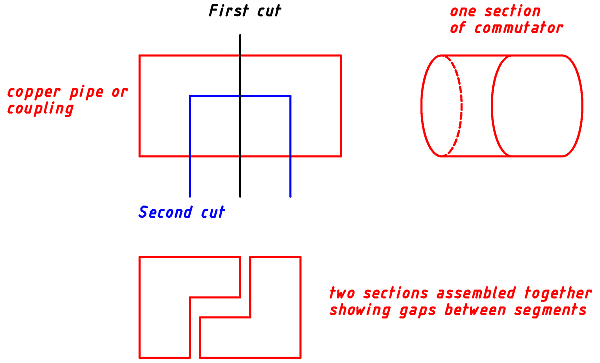 Take your piece of copper pipe or connector and clean with fine emery or pan scourer.
Take your piece of copper pipe or connector and clean with fine emery or pan scourer.
Cut it in half as shown here; then cut a section out of each to make two "L" shaped pieces.
Fit the two pieces together over the pipe so the gaps between them are symmetrical.
Now fit the pipe over the shaft. If its a loose fit you will need to pack it so it doesnt wobble. You can wrap a strip of paper around the shaft like you did for the coil. The commutator can now be fastened in place on the shaft with a nut either end.
Assembly
Refer to the diagram below.
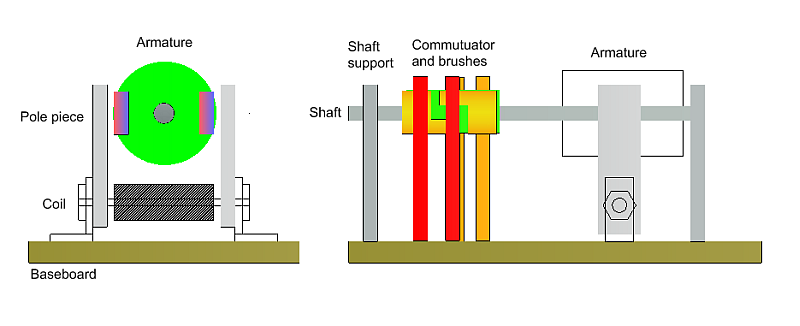
Having fitted your rotor and commutator to the shaft you can now mount it between L brackets on the baseboard. You may need to drill or file out the holes for the shaft to fit through. Fix it in place with nuts and washers so it can freely rotate. A dab of nail varnish will stop the nuts working loose.
Now fit the coil between the second pair of angle brackets and fix to the baseboard.
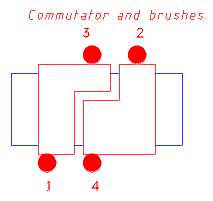 Take 4 pieces of stiff wire and fix it firmly to the baseboard. It may help to fit a wooden block between them to hold them in place. Make sure you can access the bottom ends of the wires. Tie the ends of the coil tails to brushes 3 and 4.
Take 4 pieces of stiff wire and fix it firmly to the baseboard. It may help to fit a wooden block between them to hold them in place. Make sure you can access the bottom ends of the wires. Tie the ends of the coil tails to brushes 3 and 4.
Adjust the brushes by bending the wire so they are gently pressed against the commutator as shown here.
Now connect a 1.5V AA cell between brushes 1 and 2 using bell wire.
The motor should turn. You will need to adjust the orientation of the armature on the shaft for best results.
Wiring diagram

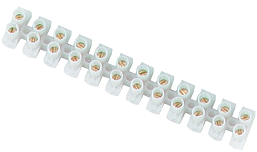 This shows how the brushes are connected to coil and battery. You can use a terminal strip like this to make the connections.
This shows how the brushes are connected to coil and battery. You can use a terminal strip like this to make the connections.
How it works
The battery causes current to flow through the coil.
As the commutator turns:
- the battery positive is connected through brush 1 to the commutator , then through brush 3 to the top of the coil. Current flows through the coil and returns through brush 4 then brush 2 to the battery negative.
A magnetic field is created which attracts the armature magnets and the shaft turns. - Brushes 3 and 4 momentarily lose contact with the commutator.
- the battery positive is connected through brush 1 to the commutator , then through brush 4 to the bottom of the coil. Current flows through the coil and returns through brush 3 then brush 2 to the battery negative.
A magnetic field is created which attracts the armature magnets and the shaft turns. - Brushes 3 and 4 momentarily lose contact with the commutator.
and the cycle repeats
If you find this hard to follow, try drawing the circuit and showing how the current flow changes as the commutator "switch" is changed from one position to another.
Make a really strong electromagnet
Put simply, the "strength" of an electromagnet (where there is a large gap between poles) is given
by m = N I A / L
where
N=no of turns
I = current in amps
A = cross-sectional area of core
L = length between poles.
So (ideally) you need to maximize N, I and A and minimize L. However in real life, if you make A large you use more wire for each turn - so the resistance increases - also the cost.
To minimize L we are going to make a horseshoe type magnet.
Heres how to make a REALLY GOOD electromagnet.
First get a length of studding (300mm) or TWO steel bolts around 8 - 12 mm diameter, and say 4 inches= 100mm long. You will need around a dozen nuts and washers to fit.
Make a coil as described above, but a bit longer - say 70mm. You can test the strength of this electromagnet when its made, but we aint finished yet!
Calculations - ( skip this if you wish )
36SWG = 32AWG = 0.2mm dia - that gets 5 turns per mm, so a single 70mm coil (tightly wound) will have 350 turns.
(more likely 330)
Each turn is (say) 12mm dia so the length of a turn is 2 * pi * r = pi * d = 40mm.
So we use 330 * 40mm = 13.2 m (=0.013km) of wire.
The mass of 36SWG is 260 u kg/m = 0.26 g / m so 1 winding takes 0.26 * 13.2 = 3.4g
The resistance of 36SWG is 0.6 ohms per m so our coil will have r = 0.6 * 13.2 = 8 ohms.
A 4 layer coil (4 windings) will have 1300 turns, use 15g of wire and have R = 32 ohms
Construction
Continue winding as described above until you have completed 4 windings. The best way to do this is to mount your core in a bench drill or lathe on a slow speed, and wind the wire on carefully as the core turns. Wen each winding reaches the end, wrap a layer of thin tissue on (toilet paper is fine). A dab of PVA glue will hold it in place. Then continue winding up or down the core. When your coil is complete tie the ends of the coil wires together to prevent the last turns from unwinding.
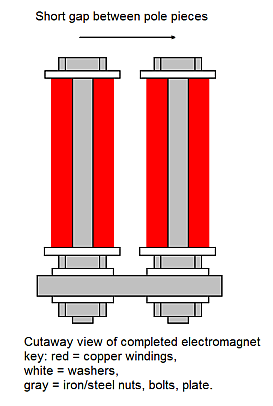
Here is the completed electromagnet. You will need to make a pair of coils, and connect them together by drilling holes in a piece of iron so they make a horseshoe shape as shown here.
You now need to conect up the coils.
Clean the varnish off the ends of 1 coil, and touch cross a 1.5V battery. The magnet should attract any iron or steel object. Do the same with the other coil.
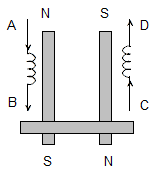
If you want to run the magnet from a low voltage, (between 1.5 and 6 volts) connect the coils in parallel.
(ie connect A to C to positive and B to D to negative supply)
To run from a higher voltage - say 12V - wire them in series.
(ie connect Positive to A, B to C, and negative to D.)
If the resulting magnet seems very weak you have connected them incorrectly, and you will need to swap around the connections FOR ONE COIL ONLY.
